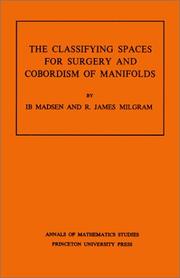
ISBN: 0691082251 069108226X 1400881471 Year: 1979 Publisher: Princeton : Tokyo : Princeton University Press Tokyo university press,
Abstract | Keywords | Export | Availability | Bookmark
 Loading...
Loading...Choose an application
- Reference Manager
- EndNote
- RefWorks (Direct export to RefWorks)
Beginning with a general discussion of bordism, Professors Madsen and Milgram present the homotopy theory of the surgery classifying spaces and the classifying spaces for the various required bundle theories. The next part covers more recent work on the maps between these spaces and the properties of the PL and Top characteristic classes, and includes integrality theorems for topological and PL manifolds. Later chapters treat the integral cohomology of BPL and Btop. The authors conclude with a discussion of the PL and topological cobordism rings and a construction of the torsion-free generators.
Algebraic topology --- 515.16 --- Classifying spaces --- Cobordism theory --- Manifolds (Mathematics) --- Surgery (Topology) --- Differential topology --- Homotopy equivalences --- Topology --- Geometry, Differential --- Spaces, Classifying --- Fiber bundles (Mathematics) --- Fiber spaces (Mathematics) --- Topology of manifolds --- Classifying spaces. --- Cobordism theory. --- Manifolds (Mathematics). --- Surgery (Topology). --- 515.16 Topology of manifolds --- Bijection. --- Calculation. --- Characteristic class. --- Classification theorem. --- Classifying space. --- Closed manifold. --- Cobordism. --- Coefficient. --- Cohomology. --- Commutative diagram. --- Commutative property. --- Complex projective space. --- Connected sum. --- Corollary. --- Cup product. --- Diagram (category theory). --- Differentiable manifold. --- Disjoint union. --- Disk (mathematics). --- Effective method. --- Eilenberg–Moore spectral sequence. --- Elaboration. --- Equivalence class. --- Exact sequence. --- Exterior algebra. --- Fiber bundle. --- Fibration. --- Function composition. --- H-space. --- Homeomorphism. --- Homomorphism. --- Homotopy fiber. --- Homotopy group. --- Homotopy. --- Hopf algebra. --- Iterative method. --- Loop space. --- Manifold. --- Massey product. --- N-sphere. --- Normal bundle. --- Obstruction theory. --- Pairing. --- Permutation. --- Piecewise linear manifold. --- Piecewise linear. --- Polynomial. --- Prime number. --- Projective space. --- Sequence. --- Simply connected space. --- Special case. --- Spin structure. --- Steenrod algebra. --- Subset. --- Summation. --- Tensor product. --- Theorem. --- Topological group. --- Topological manifold. --- Topology. --- Total order. --- Variétés topologiques --- Topologie differentielle
Book
ISBN: 0691615004 0691642575 1400856450 9781400856459 0691082901 9780691082905 9780691615004 9780691615004 9780691642574 Year: 2014 Publisher: Princeton, NJ : Princeton University Press,
Abstract | Keywords | Export | Availability | Bookmark
 Loading...
Loading...Choose an application
- Reference Manager
- EndNote
- RefWorks (Direct export to RefWorks)
Mathematical No/ex, 27Originally published in 1981.The Princeton Legacy Library uses the latest print-on-demand technology to again make available previously out-of-print books from the distinguished backlist of Princeton University Press. These editions preserve the original texts of these important books while presenting them in durable paperback and hardcover editions. The goal of the Princeton Legacy Library is to vastly increase access to the rich scholarly heritage found in the thousands of books published by Princeton University Press since its founding in 1905.
Riemannian manifolds. --- Minimal surfaces. --- Surfaces, Minimal --- Maxima and minima --- Manifolds, Riemannian --- Riemannian space --- Space, Riemannian --- Geometry, Differential --- Manifolds (Mathematics) --- Differential geometry. Global analysis --- Addition. --- Analytic function. --- Branch point. --- Calculation. --- Cartesian coordinate system. --- Closed geodesic. --- Codimension. --- Coefficient. --- Compactness theorem. --- Compass-and-straightedge construction. --- Continuous function. --- Corollary. --- Counterexample. --- Covering space. --- Curvature. --- Curve. --- Decomposition theorem. --- Derivative. --- Differentiable manifold. --- Differential geometry. --- Disjoint union. --- Equation. --- Essential singularity. --- Estimation. --- Euclidean space. --- Existence theorem. --- Existential quantification. --- First variation. --- Flat topology. --- Fundamental group. --- Geometric measure theory. --- Great circle. --- Homology (mathematics). --- Homotopy group. --- Homotopy. --- Hyperbolic function. --- Hypersurface. --- Integer. --- Line–line intersection. --- Manifold. --- Measure (mathematics). --- Minimal surface. --- Monograph. --- Natural number. --- Open set. --- Parameter. --- Partition of unity. --- Pointwise. --- Quantity. --- Regularity theorem. --- Riemann surface. --- Riemannian manifold. --- Scalar curvature. --- Scientific notation. --- Second fundamental form. --- Sectional curvature. --- Sequence. --- Sign (mathematics). --- Simply connected space. --- Smoothness. --- Sobolev inequality. --- Solid torus. --- Subgroup. --- Submanifold. --- Summation. --- Theorem. --- Topology. --- Two-dimensional space. --- Unit sphere. --- Upper and lower bounds. --- Varifold. --- Weak topology.
Book
Year: 2021 Publisher: Basel, Switzerland MDPI - Multidisciplinary Digital Publishing Institute
Abstract | Keywords | Export | Availability | Bookmark
 Loading...
Loading...Choose an application
- Reference Manager
- EndNote
- RefWorks (Direct export to RefWorks)
Complex networks are one of the most challenging research focuses of disciplines, including physics, mathematics, biology, medicine, engineering, and computer science, among others. The interest in complex networks is increasingly growing, due to their ability to model several daily life systems, such as technology networks, the Internet, and communication, chemical, neural, social, political and financial networks. The Special Issue “Computation in Complex Networks" of Entropy offers a multidisciplinary view on how some complex systems behave, providing a collection of original and high-quality papers within the research fields of: • Community detection • Complex network modelling • Complex network analysis • Node classification • Information spreading and control • Network robustness • Social networks • Network medicine
Technology: general issues --- city interaction network --- evolution model --- preferential attachment --- WeChat --- maximum likelihood --- chimera states --- coupled map lattice --- nilpotent matrix --- community detection --- membrane algorithm --- self-organizing map network --- complex networks --- optimization --- structural balance --- minimum memory based sign adjustment --- social networks --- NW network --- convergence --- complex system simulation --- cloud computing architecture --- service-oriented modeling --- semantic search framework --- QoS-based service selection --- cascading failures --- network topology --- null models --- SciSci --- knowledge evolution --- machine learning --- bridging centrality --- disjoint nodes --- disjunct nodes --- node similarity --- overlapping nodes --- Bayesian networks --- entropy --- socio-ecological system --- complex network --- chaotic time series --- Gaussian mixture model --- maximum mean discrepancy --- angiogenesis --- network properties --- variational inference --- graph neural network --- variational autoencoder --- network embedding --- online social networks --- social media --- information spreading --- information diffusion --- cross-entropy --- cross-domain recommendation --- sentiment analysis --- latent sentiment review feature --- non-linear mapping --- dissimilarity spaces --- support vector machines --- kernel methods --- computational biology --- systems biology --- protein contact networks --- data mining --- overlapping communities --- modularity --- literary works --- genre classification --- stylistic attributes --- lemmatization --- renormalisation process --- network growth --- inverse preferential attachment --- language networks --- language development --- multilayer complex networks --- stability --- spreading control --- graph neural networks --- node classification --- active learning --- graph representation learning --- city interaction network --- evolution model --- preferential attachment --- WeChat --- maximum likelihood --- chimera states --- coupled map lattice --- nilpotent matrix --- community detection --- membrane algorithm --- self-organizing map network --- complex networks --- optimization --- structural balance --- minimum memory based sign adjustment --- social networks --- NW network --- convergence --- complex system simulation --- cloud computing architecture --- service-oriented modeling --- semantic search framework --- QoS-based service selection --- cascading failures --- network topology --- null models --- SciSci --- knowledge evolution --- machine learning --- bridging centrality --- disjoint nodes --- disjunct nodes --- node similarity --- overlapping nodes --- Bayesian networks --- entropy --- socio-ecological system --- complex network --- chaotic time series --- Gaussian mixture model --- maximum mean discrepancy --- angiogenesis --- network properties --- variational inference --- graph neural network --- variational autoencoder --- network embedding --- online social networks --- social media --- information spreading --- information diffusion --- cross-entropy --- cross-domain recommendation --- sentiment analysis --- latent sentiment review feature --- non-linear mapping --- dissimilarity spaces --- support vector machines --- kernel methods --- computational biology --- systems biology --- protein contact networks --- data mining --- overlapping communities --- modularity --- literary works --- genre classification --- stylistic attributes --- lemmatization --- renormalisation process --- network growth --- inverse preferential attachment --- language networks --- language development --- multilayer complex networks --- stability --- spreading control --- graph neural networks --- node classification --- active learning --- graph representation learning
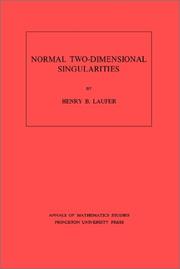
ISBN: 069108100X 1400881749 9780691081007 Year: 1971 Volume: 71 Publisher: Princeton : Princeton University Press,
Abstract | Keywords | Export | Availability | Bookmark
 Loading...
Loading...Choose an application
- Reference Manager
- EndNote
- RefWorks (Direct export to RefWorks)
A survey, thorough and timely, of the singularities of two-dimensional normal complex analytic varieties, the volume summarizes the results obtained since Hirzebruch's thesis (1953) and presents new contributions. First, the singularity is resolved and shown to be classified by its resolution; then, resolutions are classed by the use of spaces with nilpotents; finally, the spaces with nilpotents are determined by means of the local ring structure of the singularity.
Algebraic geometry --- Analytic spaces --- SINGULARITIES (Mathematics) --- 512.76 --- Singularities (Mathematics) --- Geometry, Algebraic --- Spaces, Analytic --- Analytic functions --- Functions of several complex variables --- Birational geometry. Mappings etc. --- Analytic spaces. --- Singularities (Mathematics). --- 512.76 Birational geometry. Mappings etc. --- Birational geometry. Mappings etc --- Analytic function. --- Analytic set. --- Analytic space. --- Automorphism. --- Bernhard Riemann. --- Big O notation. --- Calculation. --- Chern class. --- Codimension. --- Coefficient. --- Cohomology. --- Compact Riemann surface. --- Complex manifold. --- Computation. --- Connected component (graph theory). --- Continuous function. --- Contradiction. --- Coordinate system. --- Corollary. --- Covering space. --- Dimension. --- Disjoint union. --- Divisor. --- Dual graph. --- Elliptic curve. --- Elliptic function. --- Embedding. --- Existential quantification. --- Factorization. --- Fiber bundle. --- Finite set. --- Formal power series. --- Hausdorff space. --- Holomorphic function. --- Homeomorphism. --- Homology (mathematics). --- Intersection (set theory). --- Intersection number (graph theory). --- Inverse limit. --- Irreducible component. --- Isolated singularity. --- Iteration. --- Lattice (group). --- Line bundle. --- Linear combination. --- Line–line intersection. --- Local coordinates. --- Local ring. --- Mathematical induction. --- Maximal ideal. --- Meromorphic function. --- Monic polynomial. --- Nilpotent. --- Normal bundle. --- Open set. --- Parameter. --- Plane curve. --- Pole (complex analysis). --- Power series. --- Presheaf (category theory). --- Projective line. --- Quadratic transformation. --- Quantity. --- Riemann surface. --- Riemann–Roch theorem. --- Several complex variables. --- Submanifold. --- Subset. --- Tangent bundle. --- Tangent space. --- Tensor algebra. --- Theorem. --- Topological space. --- Transition function. --- Two-dimensional space. --- Variable (mathematics). --- Zero divisor. --- Zero of a function. --- Zero set. --- Variétés complexes --- Espaces analytiques
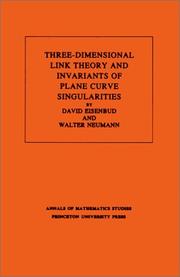
ISBN: 0691083819 0691083800 1400881927 9780691083810 9780691083803 Year: 1985 Volume: 110 Publisher: Princeton Princeton University Press
Abstract | Keywords | Export | Availability | Bookmark
 Loading...
Loading...Choose an application
- Reference Manager
- EndNote
- RefWorks (Direct export to RefWorks)
This book gives a new foundation for the theory of links in 3-space modeled on the modern developmentby Jaco, Shalen, Johannson, Thurston et al. of the theory of 3-manifolds. The basic construction is a method of obtaining any link by "splicing" links of the simplest kinds, namely those whose exteriors are Seifert fibered or hyperbolic. This approach to link theory is particularly attractive since most invariants of links are additive under splicing.Specially distinguished from this viewpoint is the class of links, none of whose splice components is hyperbolic. It includes all links constructed by cabling and connected sums, in particular all links of singularities of complex plane curves. One of the main contributions of this monograph is the calculation of invariants of these classes of links, such as the Alexander polynomials, monodromy, and Seifert forms.
Algebraic geometry --- Differential geometry. Global analysis --- Link theory. --- Curves, Plane. --- SINGULARITIES (Mathematics) --- Curves, Plane --- Invariants --- Link theory --- Singularities (Mathematics) --- Geometry, Algebraic --- Low-dimensional topology --- Piecewise linear topology --- Higher plane curves --- Plane curves --- Invariants. --- 3-sphere. --- Alexander Grothendieck. --- Alexander polynomial. --- Algebraic curve. --- Algebraic equation. --- Algebraic geometry. --- Algebraic surface. --- Algorithm. --- Ambient space. --- Analytic function. --- Approximation. --- Big O notation. --- Call graph. --- Cartesian coordinate system. --- Characteristic polynomial. --- Closed-form expression. --- Cohomology. --- Computation. --- Conjecture. --- Connected sum. --- Contradiction. --- Coprime integers. --- Corollary. --- Curve. --- Cyclic group. --- Determinant. --- Diagram (category theory). --- Diffeomorphism. --- Dimension. --- Disjoint union. --- Eigenvalues and eigenvectors. --- Equation. --- Equivalence class. --- Euler number. --- Existential quantification. --- Exterior (topology). --- Fiber bundle. --- Fibration. --- Foliation. --- Fundamental group. --- Geometry. --- Graph (discrete mathematics). --- Ground field. --- Homeomorphism. --- Homology sphere. --- Identity matrix. --- Integer matrix. --- Intersection form (4-manifold). --- Isolated point. --- Isolated singularity. --- Jordan normal form. --- Knot theory. --- Mathematical induction. --- Monodromy matrix. --- Monodromy. --- N-sphere. --- Natural transformation. --- Newton polygon. --- Newton's method. --- Normal (geometry). --- Notation. --- Pairwise. --- Parametrization. --- Plane curve. --- Polynomial. --- Power series. --- Projective plane. --- Puiseux series. --- Quantity. --- Rational function. --- Resolution of singularities. --- Riemann sphere. --- Riemann surface. --- Root of unity. --- Scientific notation. --- Seifert surface. --- Set (mathematics). --- Sign (mathematics). --- Solid torus. --- Special case. --- Stereographic projection. --- Submanifold. --- Summation. --- Theorem. --- Three-dimensional space (mathematics). --- Topology. --- Torus knot. --- Torus. --- Tubular neighborhood. --- Unit circle. --- Unit vector. --- Unknot. --- Variable (mathematics).
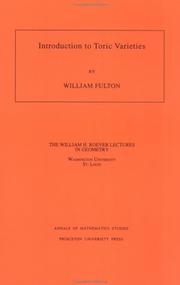
ISBN: 0691000492 0691033323 1400882524 Year: 1993 Publisher: Princeton Princeton university press
Abstract | Keywords | Export | Availability | Bookmark
 Loading...
Loading...Choose an application
- Reference Manager
- EndNote
- RefWorks (Direct export to RefWorks)
Toric varieties are algebraic varieties arising from elementary geometric and combinatorial objects such as convex polytopes in Euclidean space with vertices on lattice points. Since many algebraic geometry notions such as singularities, birational maps, cycles, homology, intersection theory, and Riemann-Roch translate into simple facts about polytopes, toric varieties provide a marvelous source of examples in algebraic geometry. In the other direction, general facts from algebraic geometry have implications for such polytopes, such as to the problem of the number of lattice points they contain. In spite of the fact that toric varieties are very special in the spectrum of all algebraic varieties, they provide a remarkably useful testing ground for general theories. The aim of this mini-course is to develop the foundations of the study of toric varieties, with examples, and describe some of these relations and applications. The text concludes with Stanley's theorem characterizing the numbers of simplicies in each dimension in a convex simplicial polytope. Although some general theorems are "ed without proof, the concrete interpretations via simplicial geometry should make the text accessible to beginners in algebraic geometry.
Algebraic geometry --- Differential geometry. Global analysis --- 512.7 --- Algebraic geometry. Commutative rings and algebras --- Toric varieties. --- 512.7 Algebraic geometry. Commutative rings and algebras --- Toric varieties --- Embeddings, Torus --- Torus embeddings --- Varieties, Toric --- Algebraic varieties --- Addition. --- Affine plane. --- Affine space. --- Affine variety. --- Alexander Grothendieck. --- Alexander duality. --- Algebraic curve. --- Algebraic group. --- Atiyah–Singer index theorem. --- Automorphism. --- Betti number. --- Big O notation. --- Characteristic class. --- Chern class. --- Chow group. --- Codimension. --- Cohomology. --- Combinatorics. --- Commutative property. --- Complete intersection. --- Convex polytope. --- Convex set. --- Coprime integers. --- Cotangent space. --- Dedekind sum. --- Dimension (vector space). --- Dimension. --- Direct proof. --- Discrete valuation ring. --- Discrete valuation. --- Disjoint union. --- Divisor (algebraic geometry). --- Divisor. --- Dual basis. --- Dual space. --- Equation. --- Equivalence class. --- Equivariant K-theory. --- Euler characteristic. --- Exact sequence. --- Explicit formula. --- Facet (geometry). --- Fundamental group. --- Graded ring. --- Grassmannian. --- H-vector. --- Hirzebruch surface. --- Hodge theory. --- Homogeneous coordinates. --- Homomorphism. --- Hypersurface. --- Intersection theory. --- Invertible matrix. --- Invertible sheaf. --- Isoperimetric inequality. --- Lattice (group). --- Leray spectral sequence. --- Limit point. --- Line bundle. --- Line segment. --- Linear subspace. --- Local ring. --- Mathematical induction. --- Mixed volume. --- Moduli space. --- Moment map. --- Monotonic function. --- Natural number. --- Newton polygon. --- Open set. --- Picard group. --- Pick's theorem. --- Polytope. --- Projective space. --- Quadric. --- Quotient space (topology). --- Regular sequence. --- Relative interior. --- Resolution of singularities. --- Restriction (mathematics). --- Resultant. --- Riemann–Roch theorem. --- Serre duality. --- Sign (mathematics). --- Simplex. --- Simplicial complex. --- Simultaneous equations. --- Spectral sequence. --- Subgroup. --- Subset. --- Summation. --- Surjective function. --- Tangent bundle. --- Theorem. --- Topology. --- Toric variety. --- Unit disk. --- Vector space. --- Weil conjecture. --- Zariski topology.
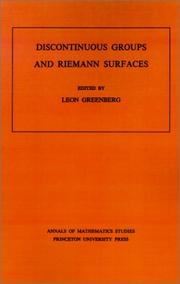
ISBN: 0691081387 1400881641 9780691081380 Year: 1974 Volume: 79 Publisher: Princeton : Princeton University Press,
Abstract | Keywords | Export | Availability | Bookmark
 Loading...
Loading...Choose an application
- Reference Manager
- EndNote
- RefWorks (Direct export to RefWorks)
Study 79 contains a collection of papers presented at the Conference on Discontinuous Groups and Ricmann Surfaces at the University of Maryland, May 21-25, 1973. The papers, by leading authorities, deal mainly with Fuchsian and Kleinian groups, Teichmüller spaces, Jacobian varieties, and quasiconformal mappings. These topics are intertwined, representing a common meeting of algebra, geometry, and analysis.
Group theory --- Complex analysis --- Number theory --- RIEMANN SURFACES --- Discontinuous groups --- congresses --- Congresses --- Riemann surfaces --- Congresses. --- Groupes discontinus --- Combinatorial topology --- Functions of complex variables --- Surfaces, Riemann --- Functions --- Abelian variety. --- Adjunction (field theory). --- Affine space. --- Algebraic curve. --- Algebraic structure. --- Analytic function. --- Arithmetic genus. --- Automorphism. --- Bernhard Riemann. --- Boundary (topology). --- Cauchy sequence. --- Cauchy–Schwarz inequality. --- Cayley–Hamilton theorem. --- Closed geodesic. --- Combination. --- Commutative diagram. --- Commutator subgroup. --- Compact Riemann surface. --- Complex dimension. --- Complex manifold. --- Complex multiplication. --- Complex space. --- Complex torus. --- Congruence subgroup. --- Conjugacy class. --- Convex set. --- Cyclic group. --- Degeneracy (mathematics). --- Diagram (category theory). --- Diffeomorphism. --- Differential form. --- Dimension (vector space). --- Disjoint sets. --- E7 (mathematics). --- Endomorphism. --- Equation. --- Equivalence class. --- Euclidean space. --- Existence theorem. --- Existential quantification. --- Finite group. --- Finitely generated group. --- Fuchsian group. --- Fundamental domain. --- Fundamental lemma (Langlands program). --- Fundamental polygon. --- Galois extension. --- Holomorphic function. --- Homeomorphism. --- Homology (mathematics). --- Homomorphism. --- Hurwitz's theorem (number theory). --- Inclusion map. --- Inequality (mathematics). --- Inner automorphism. --- Intersection (set theory). --- Irreducibility (mathematics). --- Isomorphism class. --- Isomorphism theorem. --- Jacobian variety. --- Jordan curve theorem. --- Kleinian group. --- Limit point. --- Mapping class group. --- Metric space. --- Monodromy. --- Monomorphism. --- Möbius transformation. --- Non-Euclidean geometry. --- Orthogonal trajectory. --- Permutation. --- Polynomial. --- Power series. --- Projective variety. --- Quadratic differential. --- Quadric. --- Quasi-projective variety. --- Quasiconformal mapping. --- Quotient space (topology). --- Rectangle. --- Riemann mapping theorem. --- Riemann surface. --- Schwarzian derivative. --- Simply connected space. --- Simultaneous equations. --- Special case. --- Subgroup. --- Subsequence. --- Surjective function. --- Symmetric space. --- Tangent space. --- Teichmüller space. --- Theorem. --- Topological space. --- Topology. --- Uniqueness theorem. --- Unit disk. --- Variable (mathematics). --- Winding number. --- Word problem (mathematics). --- RIEMANN SURFACES - congresses --- Discontinuous groups - Congresses --- Geometrie algebrique --- Fonctions d'une variable complexe --- Surfaces de riemann
Book
ISBN: 0691080291 1322884943 069164554X 1400869293 9781400869299 9780691618548 0691618542 Year: 2015 Publisher: Princeton, NJ : Princeton University Press,
Abstract | Keywords | Export | Availability | Bookmark
 Loading...
Loading...Choose an application
- Reference Manager
- EndNote
- RefWorks (Direct export to RefWorks)
This book is a sequel to Lectures on Complex Analytic Varieties: The Local Paranwtrization Theorem (Mathematical Notes 10, 1970). Its unifying theme is the study of local properties of finite analytic mappings between complex analytic varieties; these mappings are those in several dimensions that most closely resemble general complex analytic mappings in one complex dimension. The purpose of this volume is rather to clarify some algebraic aspects of the local study of complex analytic varieties than merely to examine finite analytic mappings for their own sake.Originally published in 1970.The Princeton Legacy Library uses the latest print-on-demand technology to again make available previously out-of-print books from the distinguished backlist of Princeton University Press. These editions preserve the original texts of these important books while presenting them in durable paperback and hardcover editions. The goal of the Princeton Legacy Library is to vastly increase access to the rich scholarly heritage found in the thousands of books published by Princeton University Press since its founding in 1905.
Complex analysis --- Analytic spaces --- Mathematics --- Physical Sciences & Mathematics --- Calculus --- Spaces, Analytic --- Analytic functions --- Functions of several complex variables --- Algebra homomorphism. --- Algebraic curve. --- Algebraic extension. --- Algebraic surface. --- Algebraic variety. --- Analytic continuation. --- Analytic function. --- Associated prime. --- Atlas (topology). --- Automorphism. --- Bernhard Riemann. --- Big O notation. --- Branch point. --- Change of variables. --- Characterization (mathematics). --- Codimension. --- Coefficient. --- Cohomology. --- Complete intersection. --- Complex analysis. --- Complex conjugate. --- Complex dimension. --- Complex number. --- Connected component (graph theory). --- Corollary. --- Critical point (mathematics). --- Diagram (category theory). --- Dimension (vector space). --- Dimension. --- Disjoint union. --- Divisor. --- Equation. --- Equivalence class. --- Exact sequence. --- Existential quantification. --- Finitely generated module. --- Geometry. --- Hamiltonian mechanics. --- Holomorphic function. --- Homeomorphism. --- Homological dimension. --- Homomorphism. --- Hypersurface. --- Ideal (ring theory). --- Identity element. --- Induced homomorphism. --- Inequality (mathematics). --- Injective function. --- Integral domain. --- Invertible matrix. --- Irreducible component. --- Isolated singularity. --- Isomorphism class. --- Jacobian matrix and determinant. --- Linear map. --- Linear subspace. --- Local ring. --- Mathematical induction. --- Mathematics. --- Maximal element. --- Maximal ideal. --- Meromorphic function. --- Modular arithmetic. --- Module (mathematics). --- Module homomorphism. --- Monic polynomial. --- Monomial. --- Neighbourhood (mathematics). --- Noetherian. --- Open set. --- Parametric equation. --- Parametrization. --- Permutation. --- Polynomial ring. --- Polynomial. --- Power series. --- Quadratic form. --- Quotient module. --- Regular local ring. --- Removable singularity. --- Ring (mathematics). --- Ring homomorphism. --- Row and column vectors. --- Scalar multiplication. --- Scientific notation. --- Several complex variables. --- Sheaf (mathematics). --- Special case. --- Subalgebra. --- Submanifold. --- Subset. --- Summation. --- Surjective function. --- Taylor series. --- Theorem. --- Three-dimensional space (mathematics). --- Topological space. --- Vector space. --- Weierstrass preparation theorem. --- Zero divisor. --- Fonctions de plusieurs variables complexes --- Variétés complexes
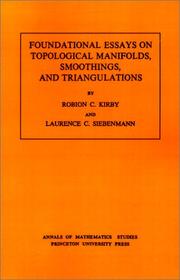
ISBN: 0691081905 0691081913 1400881501 9780691081908 Year: 1977 Volume: no. 88 Publisher: Princeton : Tokyo : Princeton University Press University of Tokyo press,
Abstract | Keywords | Export | Availability | Bookmark
 Loading...
Loading...Choose an application
- Reference Manager
- EndNote
- RefWorks (Direct export to RefWorks)
Since Poincaré's time, topologists have been most concerned with three species of manifold. The most primitive of these--the TOP manifolds--remained rather mysterious until 1968, when Kirby discovered his now famous torus unfurling device. A period of rapid progress with TOP manifolds ensued, including, in 1969, Siebenmann's refutation of the Hauptvermutung and the Triangulation Conjecture. Here is the first connected account of Kirby's and Siebenmann's basic research in this area.The five sections of this book are introduced by three articles by the authors that initially appeared between 1968 and 1970. Appendices provide a full discussion of the classification of homotopy tori, including Casson's unpublished work and a consideration of periodicity in topological surgery.
Differential geometry. Global analysis --- Manifolds (Mathematics) --- Piecewise linear topology --- Triangulating manifolds --- Variétés (Mathématiques) --- Topologie linéaire par morceaux --- 515.16 --- Manifolds, Triangulating --- PL topology --- Topology --- Geometry, Differential --- Topology of manifolds --- Piecewise linear topology. --- Triangulating manifolds. --- Manifolds (Mathematics). --- 515.16 Topology of manifolds --- Variétés (Mathématiques) --- Topologie linéaire par morceaux --- Triangulation. --- Triangulation --- Affine space. --- Algebraic topology (object). --- Approximation. --- Associative property. --- Automorphism. --- Big O notation. --- CW complex. --- Calculation. --- Cap product. --- Cartesian product. --- Category of sets. --- Chain complex. --- Classification theorem. --- Classifying space. --- Cobordism. --- Codimension. --- Cofibration. --- Cohomology. --- Connected space. --- Continuous function (set theory). --- Continuous function. --- Counterexample. --- Diffeomorphism. --- Differentiable manifold. --- Differential structure. --- Differential topology. --- Dimension (vector space). --- Direct proof. --- Disjoint union. --- Elementary proof. --- Embedding. --- Euclidean space. --- Existence theorem. --- Existential quantification. --- Fiber bundle. --- Fibration. --- General position. --- Geometry. --- Group homomorphism. --- H-cobordism. --- H-space. --- Handle decomposition. --- Handlebody. --- Hauptvermutung. --- Hausdorff space. --- Hilbert cube. --- Homeomorphism group. --- Homeomorphism. --- Homomorphism. --- Homotopy group. --- Homotopy. --- Inclusion map. --- Injective function. --- Invertible matrix. --- K-cell (mathematics). --- Kan extension. --- Linear subspace. --- Linear topology. --- Manifold. --- Mapping cylinder. --- Mathematical induction. --- Mathematician. --- Metric space. --- Morse theory. --- Neighbourhood (mathematics). --- Open set. --- Partition of unity. --- Piecewise linear manifold. --- Piecewise linear. --- Poincaré conjecture. --- Polyhedron. --- Principal bundle. --- Product metric. --- Pushout (category theory). --- Regular homotopy. --- Retract. --- Sheaf (mathematics). --- Simplicial complex. --- Smoothing. --- Spin structure. --- Stability theory. --- Stable manifold. --- Standard map. --- Submanifold. --- Submersion (mathematics). --- Subset. --- Surgery exact sequence. --- Surjective function. --- Theorem. --- Topological group. --- Topological manifold. --- Topological space. --- Topology. --- Transversal (geometry). --- Transversality (mathematics). --- Transversality theorem. --- Union (set theory). --- Uniqueness theorem. --- Vector bundle. --- Zorn's lemma. --- Variétés topologiques
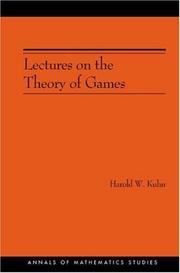
ISBN: 0691027714 0691027722 9786612159114 1282159119 1400829569 9781400829569 9781282159112 6612159111 9780691027715 9780691027722 Year: 2003 Volume: 37 Publisher: Princeton, N.J. : Princeton University Press,
Abstract | Keywords | Export | Availability | Bookmark
 Loading...
Loading...Choose an application
- Reference Manager
- EndNote
- RefWorks (Direct export to RefWorks)
This book is a spectacular introduction to the modern mathematical discipline known as the Theory of Games. Harold Kuhn first presented these lectures at Princeton University in 1952. They succinctly convey the essence of the theory, in part through the prism of the most exciting developments at its frontiers half a century ago. Kuhn devotes considerable space to topics that, while not strictly the subject matter of game theory, are firmly bound to it. These are taken mainly from the geometry of convex sets and the theory of probability distributions. The book opens by addressing "matrix games," a name first introduced in these lectures as an abbreviation for two-person, zero-sum games in normal form with a finite number of pure strategies. It continues with a treatment of games in extensive form, using a model introduced by the author in 1950 that quickly supplanted von Neumann and Morgenstern's cumbersome approach. A final section deals with games that have an infinite number of pure strategies for the two players. Throughout, the theory is generously illustrated with examples, and exercises test the reader's understanding. A historical note caps off each chapter. For readers familiar with the calculus and with elementary matrix theory or vector analysis, this book offers an indispensable store of vital insights on a subject whose importance has only grown with the years.
Operational research. Game theory --- Game theory --- 519.83 --- Theory of games --- 519.83 Theory of games --- Game theory. --- Games, Theory of --- Mathematical models --- Mathematics --- Abstract algebra. --- Addition. --- Algorithm. --- Almost surely. --- Analytic geometry. --- Axiom. --- Basic solution (linear programming). --- Big O notation. --- Bijection. --- Binary relation. --- Boundary (topology). --- Bounded set (topological vector space). --- Branch point. --- Calculation. --- Cardinality of the continuum. --- Cardinality. --- Cartesian coordinate system. --- Characteristic function (probability theory). --- Combination. --- Computation. --- Connectivity (graph theory). --- Constructive proof. --- Convex combination. --- Convex function. --- Convex hull. --- Convex set. --- Coordinate system. --- David Gale. --- Diagram (category theory). --- Differential equation. --- Dimension (vector space). --- Dimensional analysis. --- Disjoint sets. --- Distribution function. --- Embedding. --- Empty set. --- Enumeration. --- Equation. --- Equilibrium point. --- Equivalence relation. --- Estimation. --- Euclidean space. --- Existential quantification. --- Expected loss. --- Extreme point. --- Formal scheme. --- Fundamental theorem. --- Galois theory. --- Geometry. --- Hyperplane. --- Inequality (mathematics). --- Infimum and supremum. --- Integer. --- Iterative method. --- Line segment. --- Linear equation. --- Linear inequality. --- Matching Pennies. --- Mathematical induction. --- Mathematical optimization. --- Mathematical theory. --- Mathematician. --- Mathematics. --- Matrix (mathematics). --- Measure (mathematics). --- Min-max theorem. --- Minimum distance. --- Mutual exclusivity. --- Prediction. --- Probability distribution. --- Probability interpretations. --- Probability measure. --- Probability theory. --- Probability. --- Proof by contradiction. --- Quantity. --- Rank (linear algebra). --- Rational number. --- Real number. --- Requirement. --- Scientific notation. --- Sign (mathematics). --- Solution set. --- Special case. --- Statistics. --- Strategist. --- Strategy (game theory). --- Subset. --- Theorem. --- Theory of Games and Economic Behavior. --- Theory. --- Three-dimensional space (mathematics). --- Total order. --- Two-dimensional space. --- Union (set theory). --- Unit interval. --- Unit square. --- Vector Analysis. --- Vector calculus. --- Vector space.

 Search
Search Feedback
Feedback About
About Help
Help News
News